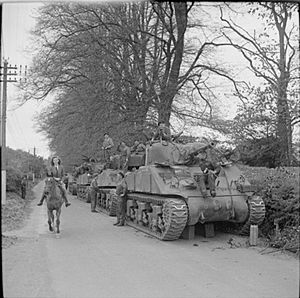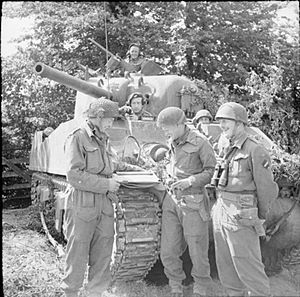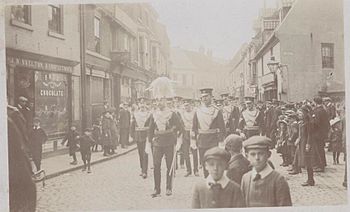East Riding of Yorkshire Yeomanry facts for kids
Quick facts for kids East Riding of Yorkshire Yeomanry |
|
|---|---|
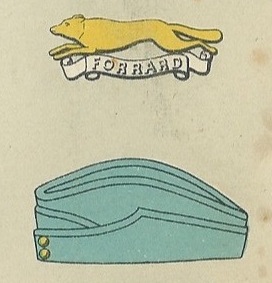
Badge and service cap as worn at the outbreak of the Second World War
|
|
| Active | 1745–1746 1794–1814 1902–1956 |
| Country | |
| Branch | |
| Type | Yeomanry |
| Size | 1–3 Regiments |
| Nickname(s) | Wenlock's Horse |
| Motto(s) | Forrard |
| Engagements | The Great War Selle Valenciennes Sambre France and Flanders 1918 Egypt 1915-17 Gaza El Mughar Nebi Samwil Palestine 1917–18 The Second World War Withdrawal to Escaut St Omer-La Bassée Cassel Normandy Landing Cambes Caen Bourguebus Ridge La Vie Crossing Lisieux Foret de Bretonne Lower Maas Venlo Pocket Ourthe Rhine North West Europe 1940, 1944 45 Pegasus Bridge |
| Commanders | |
| Notable commanders |
3rd Lord Wenlock Col Hon Guy Greville Wilson, CMG, DSO, TD |
The East Riding of Yorkshire Yeomanry was a special army unit in Britain. It was officially formed in 1902. Before that, similar groups of volunteer cavalry, called Yeomanry Cavalry, were created in the East Riding of Yorkshire during big emergencies. These included the Jacobite Rising of 1745, the French Revolutionary Wars, and the Napoleonic Wars.
These early volunteer groups were only active when needed, then they would disband. The East Riding of Yorkshire Yeomanry, started in 1902, fought in the First World War. They served both on horseback and as soldiers using machine guns.
Later, in 1920, the unit changed into an armoured regiment, using tanks. They fought bravely in the Battle of France and the campaign in North West Europe during the Second World War. Some of their soldiers even became paratroopers, jumping into battle during the Normandy landings and the Rhine Crossing. In 1956, the regiment joined with two other Yorkshire yeomanry groups to form the Queen's Own Yorkshire Yeomanry. Today, their history is carried on by the Queen's Own Yeomanry.
Contents
- Early Days: Volunteer Horsemen
- Defending Britain: French Wars
- Becoming 'Imperial' and 'Territorial'
- World War I: From Horses to Machine Guns
- Between the Wars: Tanks Arrive!
- World War II: Armoured Battles
- After the Wars: Mergers and New Units
- What They Wore: Uniforms and Badges
- Remembering Their Service
- See also
Early Days: Volunteer Horsemen
Back in 1745, during the Jacobite Rising of 1745, many volunteer groups were formed to protect the coast around Hull and the East Riding of Yorkshire. At the same time, a group of gentlemen and farmers who loved fox-hunting created a cavalry unit. They called themselves the Yorkshire Light Horse.
They asked a famous general, James Oglethorpe, to be their leader. The King, George II, even allowed them to change their name to the Royal Regiment of Hunters. Some say this was the very first Yeomanry cavalry unit ever formed in Britain! These fox-hunters did important patrol work. They even helped chase after rebels in the winter, with about 1500 well-mounted men.
Defending Britain: French Wars
When Britain got involved in the French Revolutionary Wars, the Prime Minister, William Pitt the Younger, suggested a new idea in 1794. He wanted counties to form volunteer cavalry groups called Yeoman Cavalry. These groups could be called upon by the King to defend against invasion or by local leaders to stop trouble.
Many counties formed these groups, including East Yorkshire. Thomas Grimston tried to create a cavalry force in Holderness. It was hard at first because farmers didn't want to leave their fields during harvest. They also didn't want to serve outside the East Riding. Once these issues were fixed, Grimston's group, called the East Riding Gentlemen and Yeomanry Cavalry, grew to 58 men. Another similar group, the Hull Gentleman and Yeomanry Cavalry, was also formed. Later, in 1798, Sir Christopher Sykes, 2nd Baronet, started the Yorkshire Wold Gentlemen and Yeomanry Cavalry.
There was also a less popular group called the East York Provisional Cavalry. Unlike the Yeomanry, joining this group wasn't voluntary. Horse owners were chosen by lottery to serve or provide a soldier. This group was very unpopular and was eventually disbanded in 1799.
After a short period of peace, war with France started again in 1803 (Napoleonic Wars). Captain Thomas Grimston quickly reformed his unit, now called the Grimston Yeomanry Cavalry. Sir Mark Masterman-Sykes, 3rd Baronet, also reformed his father's Yorkshire Wolds Yeomanry Cavalry, which grew to 300 members. These volunteer units continued until the war ended in 1814. For many years after that, there wasn't a Yeomanry regiment in the East Riding.
Becoming 'Imperial' and 'Territorial'
In 1899, during the Second Boer War, Britain realized it needed more soldiers. So, on December 24, 1899, the Imperial Yeomanry (IY) was created. This new force was made up of volunteers, mostly from the middle and upper classes. They were trained to fight on horseback.
The idea was a success. Before the war ended, existing Yeomanry regiments became Imperial Yeomanry. New regiments were also formed, including the East Riding of Yorkshire Imperial Yeomanry, approved in 1902.
This new unit was started by Beilby Lawley, 3rd Baron Wenlock, who became its leader. By 1903, the regiment had 400 men in four squadrons (smaller groups of cavalry) located in Hull, Beverley, York, and Bridlington. They also had a Machine Gun Section. The regiment was often called 'Wenlock's Horse' after Lord Wenlock. In 1906, they became a lancer regiment, meaning they used lances (long spears) in battle.
In 1908, the Imperial Yeomanry became part of the new Territorial Force (TF). The East Riding Yeomanry (TF) was part of the Yorkshire Mounted Brigade. Their main office was in Beverley, with squadrons spread across the region.
World War I: From Horses to Machine Guns
When World War I started on August 4, 1914, the East Riding Yeomanry was ready. The Territorial Force was meant for home defence, but many soldiers volunteered to serve overseas. Because so many volunteered, a second "2nd Line" unit was created. This 2nd Line unit had the same name but with a "2/" in front (e.g., 2/1st East Riding of Yorkshire Yeomanry). Later, a "3rd Line" was formed to train new soldiers.
Fighting in Egypt and Palestine
The 1/1st East Riding of Yorkshire Yeomanry moved north in November 1914. In May 1915, they were part of a huge parade of 40,000 men for the King and Lord Kitchener. Then, they moved to East Anglia before sailing to Alexandria in October 1915.
In 1916, they were part of the Western Frontier Force in Egypt. Many soldiers joined the new Imperial Camel Corps or worked with T. E. Lawrence. In December 1916, they joined the ANZAC Mounted Division near the Suez Canal.
The regiment first fought in the First Battle of Gaza, which was tough for both men and horses. In the Second Battle of Gaza, they were on the far right side of the battle. In October 1917, they fought in the Third Battle of Gaza. On November 13, at El Mughar, they supported a cavalry charge. 'A' Squadron led the charge, capturing their target. They pushed on, but had to pull back because they weren't supported. It turned out that the village was a Turkish army headquarters. This battle, El Mughar, was one of the last great cavalry charges by the British Army.
In December 1917, most of the regiment left their horses and went to France. They became part of the Machine Gun Corps (Mobile), using machine guns instead of fighting on horseback.
Home Defence and Cyclists
The 2/1st East Riding of Yorkshire Yeomanry was formed in September 1914. They stayed in Yorkshire for home defence. By March 1916, they were near Beverley.
In July 1916, many Yeomanry units in the UK changed roles. Most became cyclists, and the East Riding Yeomanry was one of them. Their brigade became the 11th Cyclist Brigade. Later, it was renamed the 7th Cyclist Brigade and moved to the Bridlington area. Around May 1918, the brigade moved to Ireland. The regiment was stationed in Bandon and Fermoy, County Cork. They stayed there until they were disbanded on December 12, 1919.
The 3rd Line regiment was formed in 1915 to train new soldiers. It later joined other reserve cavalry regiments.
Between the Wars: Tanks Arrive!
After World War I, in 1920, the regiment was reformed in the Territorial Army (TA). It was decided that only a few Yeomanry regiments would remain as horse cavalry. The rest, including the East Riding Yeomanry, changed roles.
On August 23, 1920, the regiment became the 26th (East Riding of York Yeomanry) Armoured Car Company, Tank Corps. This meant they now used armoured cars! The Tank Corps later became the Royal Tank Corps and then the Royal Tank Regiment in the Royal Armoured Corps (RAC).
By 1939, it was clear that another war was coming. The TA was doubled in size, and each unit formed a duplicate. So, on August 24, the 1st East Riding Yeomanry was reformed in the RAC as a Divisional Cavalry Regiment. They were equipped with light tanks, carriers, and motorcycles. At the same time, they formed their duplicate unit, the 2nd East Riding Yeomanry.
World War II: Armoured Battles
Brave Stand in France
On March 30, 1940, the 1st East Riding Yeomanry (1ERY) joined the British Expeditionary Force (BEF) in France. They were part of the 1st Armoured Reconnaissance Brigade. In May, they were involved in fighting near Ath, south of Brussels. Over the next two weeks, they fought seven rearguard actions, meaning they protected the main army as it retreated. They were finally surrounded at Cassel on May 29/30 while protecting another infantry brigade.
The remaining soldiers of 1ERY (7 officers and 230 men) returned to England. The regiment was rebuilt with new soldiers from the 2nd Regiment. They then trained with Covenanter tanks and Honey tanks. In April 1943, they got new Sherman Duplex Drive tanks. These were special tanks that could float and move in water!
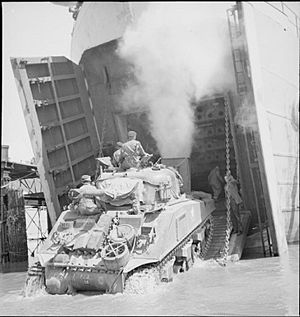
D-Day and Beyond
All their training paid off on June 6, 1944, D-Day. The Regiment landed on Sword Beach in Normandy, supporting the 9th Infantry Brigade. After failing to capture Caen on D-Day, their job was to take the high ground north of the town. The next day, 1ERY supported an attack on Cambes-en-Plaine, a strong enemy position. They faced heavy artillery, mortar, and machine gun fire. The infantry suffered many casualties, and 1ERY lost four tanks. But after tough fighting, they achieved their goal.
For 50 days after D-Day, 1ERY fought in the battles to secure the beachhead. Due to casualties, their brigade was broken up on July 29. On August 16, 1ERY joined the 33rd Armoured Brigade. They helped in the final Falaise Pocket battles, advanced to the River Seine, crossed it, and took St Valery-en-Caux. After that, they helped the 49th (West Riding) Division in the Battle of Le Havre.
In October, the regiment supported the 53rd (Welsh) Infantry Division in the Netherlands, fighting around 's-Hertogenbosch and crossing the Meuse. During the Battle of the Bulge in the winter of 1944, they were quickly sent to help stop the German attack.
Crossing the Rhine in Amphibious Vehicles
In January 1945, 1ERY got new Buffalo amphibious vehicles. These were like boats on tracks, perfect for crossing rivers. They used them for the assault crossing of the Rhine River (Operation Plunder) on March 23/24. Captain Peter Clemence of 1ERY was in charge of lighting the routes for the Buffaloes to enter the water. He had to scout the riverbank during the day under enemy fire and place lights at night. He earned the Military Cross (MC) for his bravery.
1ERY's job was to carry assault troops across the Rhine. Each infantry company got six Buffaloes, and two troops of Buffaloes carried essential equipment like anti-tank guns and medical jeeps. The operation was practiced on the Meuse River. One soldier commented that the Yeomanry were "delightful" to work with, even joking about their "horsey outlook" while in the water.
The attack began at 2:00 AM on March 24. At first, things went well. Two companies crossed the river easily. However, some Buffaloes went off course in the dark, landing troops in the wrong places. This led to tough fighting, but the soldiers eventually cleared the area. Acting Lance-Corporal Adams of 1EYR was a Buffalo driver. While unloading wounded soldiers and prisoners, they came under shellfire. Adams bravely shielded a wounded soldier from shrapnel with his own body. He was awarded the Military Medal (MM). Despite four days of fighting under fire, the regiment only had one man wounded during Operation Plunder.
For the last weeks of the war, the regiment switched back to Sherman tanks. They helped the First Canadian Army clear the Netherlands. After the war, the regiment was stationed in Germany until it was put into "suspended animation" (meaning it stopped being active) on March 7, 1946.
2nd East Riding Yeomanry: Paratroopers!
The 2nd East Riding Yeomanry (2nd ERY) was formed as a duplicate of the 1st Regiment on August 24, 1939. On June 25, 1940, it changed into an infantry unit, becoming the 10th (East Riding) Battalion, Green Howards.
From 1943, these soldiers began training as parachutists. On June 1, the battalion became the 12th (Yorkshire) Parachute Battalion, part of the famous Parachute Regiment. This battalion was part of the 5th Parachute Brigade, which belonged to the 6th Airborne Division. The battalion made combat jumps on D-Day (June 6, 1944) and during the Rhine Crossing (March 28, 1945). The ground troops of the division were ferried across the Rhine by the 1st East Riding Yeomanry.
After the Wars: Mergers and New Units
The 1st East Riding Yeomanry was reformed in the TA on January 1, 1947. In 1951, its name was shortened to East Riding Yeomanry. In 1956, the East Riding Yeomanry merged with two other yeomanry regiments: the Yorkshire Hussars and the Yorkshire Dragoons. They formed the Queen's Own Yorkshire Yeomanry. This new unit was formed on April 1, 1967, with its headquarters in York and squadrons in Doncaster and Hull. Later, on April 1, 1971, the regiment was reformed as 'A' Squadron of The Queen's Own Yeomanry.
The 12th (Yorkshire) Battalion, Parachute Regiment, was also reformed in the TA on March 1, 1947. On October 1, 1956, it joined with the 13th (Lancashire) Battalion.
What They Wore: Uniforms and Badges
The early Grimston troop in 1794 wore short scarlet (red) jackets with buff (light yellow-brown) trim and silver braid. They wore a special helmet called a Tarleton helmet with a buff 'turban' and a feather. Their belt buckle had "E.R.Y.C." (for East Riding Yeomanry Cavalry) and the motto Pro aris et focis (meaning 'for our altars and hearths' or 'for hearth and home'). They also wore white breeches and black riding boots. Other early troops wore green uniforms.
When the Grimston Yeomanry reformed in 1803, they kept the scarlet uniform but added scarlet trousers. The Yorkshire Wold Troop wore scarlet with green trim, and the Everingham Troop wore scarlet with yellow trim.
The East Riding of Yorkshire Imperial Yeomanry wore khaki uniforms for training. For special occasions, they wore a Slouch hat and a serge tunic with a blue front. When they became a lancer unit, they adopted a full dress uniform with a Chapka lance cap (a square-topped hat) and a tunic made of maroon (dark reddish-brown) cloth. This was an unusual color for the British Army! Their badge was a running fox with the motto 'Forrard', showing their foxhunting background.
Remembering Their Service
There are two carved stone memorial tablets in Beverley Minster that remember the soldiers who died in the First and Second World Wars. The former Museum of Army Transport in Beverley also had wooden boards listing the regiment's battle honours (special awards for bravery in battle) and the names of soldiers who received medals. Many items from that museum are now at the National Army Museum.
See also
- Imperial Yeomanry
- List of Yeomanry Regiments 1908
- Yeomanry order of precedence
- British yeomanry during the First World War
- Second line yeomanry regiments of the British Army


